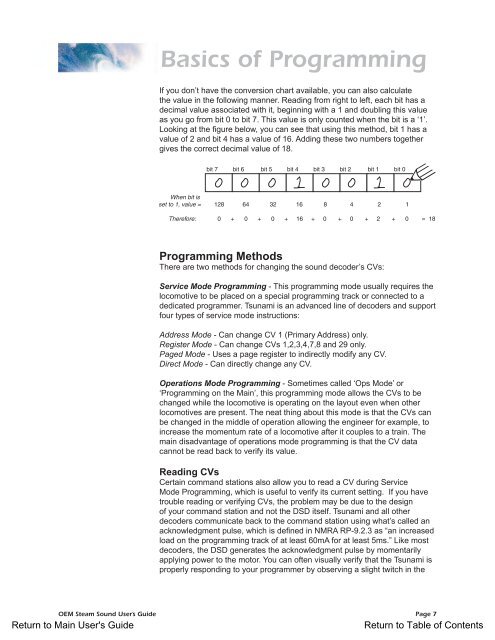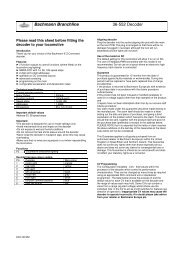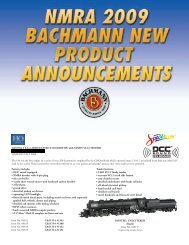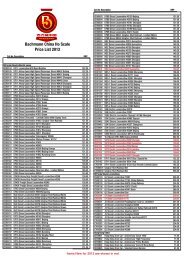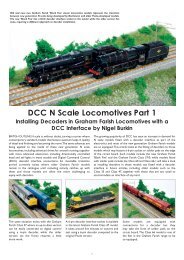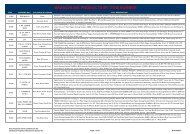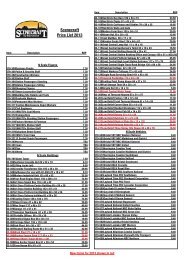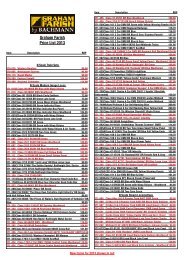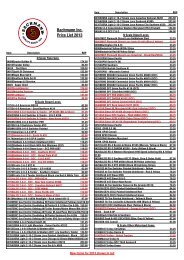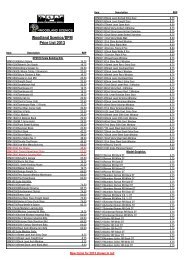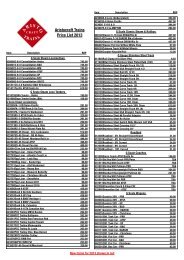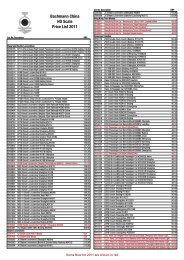Spectrum Steam Sound User Guide(1.4MB) - Bachmann
Spectrum Steam Sound User Guide(1.4MB) - Bachmann
Spectrum Steam Sound User Guide(1.4MB) - Bachmann
Create successful ePaper yourself
Turn your PDF publications into a flip-book with our unique Google optimized e-Paper software.
Basics of ProgrammingIf you don’t have the conversion chart available, you can also calculatethe value in the following manner. Reading from right to left, each bit has adecimal value associated with it, beginning with a 1 and doubling this valueas you go from bit 0 to bit 7. This value is only counted when the bit is a ‘1’.Looking at the figure below, you can see that using this method, bit 1 has avalue of 2 and bit 4 has a value of 16. Adding these two numbers togethergives the correct decimal value of 18.bit 7 bit 6 bit 5 bit 4 bit 3 bit 2 bit 1 bit 0When bit isset to 1, value = 128 64 32 16 8 4 2 1Therefore: 0 + 0 + 0 + 16 + 0 + 0 + 2 + 0 = 18Programming MethodsThere are two methods for changing the sound decoder’s CVs:Service Mode Programming - This programming mode usually requires thelocomotive to be placed on a special programming track or connected to adedicated programmer. Tsunami is an advanced line of decoders and supportfour types of service mode instructions:Address Mode - Can change CV 1 (Primary Address) only.Register Mode - Can change CVs 1,2,3,4,7,8 and 29 only.Paged Mode - Uses a page register to indirectly modify any CV.Direct Mode - Can directly change any CV.Operations Mode Programming - Sometimes called ‘Ops Mode’ or‘Programming on the Main’, this programming mode allows the CVs to bechanged while the locomotive is operating on the layout even when otherlocomotives are present. The neat thing about this mode is that the CVs canbe changed in the middle of operation allowing the engineer for example, toincrease the momentum rate of a locomotive after it couples to a train. Themain disadvantage of operations mode programming is that the CV datacannot be read back to verify its value.Reading CVsCertain command stations also allow you to read a CV during ServiceMode Programming, which is useful to verify its current setting. If you havetrouble reading or verifying CVs, the problem may be due to the designof your command station and not the DSD itself. Tsunami and all otherdecoders communicate back to the command station using what’s called anacknowledgment pulse, which is defined in NMRA RP-9.2.3 as “an increasedload on the programming track of at least 60mA for at least 5ms.” Like mostdecoders, the DSD generates the acknowledgment pulse by momentarilyapplying power to the motor. You can often visually verify that the Tsunami isproperly responding to your programmer by observing a slight twitch in theOEM <strong>Steam</strong> <strong>Sound</strong> <strong>User</strong>’s <strong>Guide</strong> Page 7Return to Main <strong>User</strong>'s <strong>Guide</strong>Return to Table of Contents


